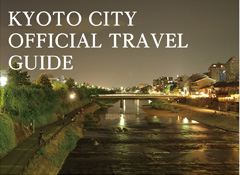【Let's take the subway】
Tourist attraction course of Rakuchu

Nishi-honganji Temple
Higashi-Honganji
Shoseien Garden Temple
Moto-Rikyu Nijo Castle
Start!
Subwai Karasuma Line Gojo Sta.
-

Toilet inside (beyond tkt barrier)
Subway Gojo Sta.
Nishi-honganji Temple
-
This is the head temple of the Jodo Shinshu Honganji School and it is often fondly referred to as Onishi-san. When the sect founder Shinran Shonin died, he was buried in a graveyard established at Otani on Higashiyama, but then enshrined in a newly erected mausoleum called Otani-byodo, located north of Yoshimizu, Higashiyama. And, this was the start of the Hongan-ji Temple. Both the Goeido hall and Amidado main hall are important cultural assets while the Hiunkaku pavilion is a national treasure, which is said to be the remains of Hideyoshi's Jurakudai mansion. Moreover, the Daishoin (large drawing r oom) g arden i s a d ry l andscape o ne c alled Kokei-no-niwa (alas, neither of these are open to the public). In 1994, the temple was registered as a World Heritage Site. The temple is equipped with barrier-free facilities such as automatic doors, Textured p aving blocks (for visually impaired) and slopes, to make visits more enjoyable. 
Toilet in tearoom and info center of
Nishi-Honganji Temple
Toilet in Ryuko-den hall at Nishi-hongan-ji Temple
Ryukoku Museum
-
Standing right next to Nishi-Hongan-ji Temple, this museum was opened by Ryukoku University (founded some 370 years ago) with the aim of deepening understanding of and enabling research of Buddhist culture. The museum displays a permanent exhibition of Buddha from his birth to the time Buddhism reached Japan. And, the museum also holds special exhibitions several times a year. On the second floor, the museum has digitally reproduced in full size one of the caves from the Bezeklik Cave Temples in Turpan, China. Although built with a modern exterior, the museum exudes the mood of Kyoto with ceramic louvers giving a sense of rattan blinds and, with a south-east through road built in, anyone can pass through the site from Horikawa-dori to Aburakoji-dori easily.
Higashi-Honganji Temple
-
This is the main temple of the Otani sect of Shinshu, and is fondly known in Kyoto as "Ohigashi-san". In 1602, Ieyasu Tokugawa split up the Hongan-ji temple, giving land to the holy priest Kyonyo for him to build the Higashi Hongan-ji Temple. Visitors passing through the Goeidomon gate are confronted by the Goeido hall, which, at 38 meters tall and big enough to hold 927 tatami mats, is one of the biggest wooden constructions in the world. An imperial wooden statue of Shinran Shonin is enshrined here. On the south side of this hall there is the Amidado main hall that holds the image of the Amida Nyorai. Restoration work started in January 2012 on the Amidado main hall and in January 2013 on the Goeidomon gate, and is scheduled to finish at the end of 2015. 
South toilet at Amadadomon gate in grounds of
Higashi-Honganji Temple
North toilet at Goeidomon gate in
Higashi-Honganji Temple
Shoseien Garden
-
Sennyo Shonin, the 13th abbot of Higashi-Hongan-ji Temple, was granted land by Iemitsu Tokugawa. On the land he built a shoin study and teahouse as a quiet place to live. The garden is said to have been created by Jozan Ishikawa, the Edo composer of Chinese poems, who named the garden Shoseien from the Chinese poem by Tao Yuanming. The garden also is known by the name of Kikokutei (literally trifoliate orange garden), as this fruit was planted in the hedges of the garden. Set in some 33,000 square meters of land, the garden comprises a large pond and a small one as well as teahouses, shoin study and thirteen elegant sceneries. There also are various blooms that come and go with the seasons. The garden is now part of a Higashi-Hongan-ji detached precinct that is a national scenic area acclaimed as a Buddhist temple garden with rich intellectual elements. 
Toilet in carpark of Shoseien Garden
-
Moto-Rikyu Nijo Castle
-
This castle was built by Ieyasu Tokugawa in 1603. The third shogun Iemitsu moved the remnants of Fushimi Castle here and extended the castle to its present size. It runs approximately 500 meters east-west and 400 meters north-south, and is surrounded by a moat. Toward the end of the shogunate, the castle was used as barracks for troops loyal to the shogun. And, it was here that Yoshinobu Tokugawa, the last shogun, announced the restoration of imperial rule. The Ninomaru palace complex (national treasure) is a representative example of samurai shoin-zukuri, or traditional style of Japanese residential architecture. The painting of pine tree and hawks by Tanyu Kano in the Yonnoma room is famous. The cherry blossoms too are famous and are illuminated at night each year. The castle was registered as a World Heritage Site in 1994. If requests are made at the entrance, wheelchair users can enter the Ninomaru palace complex (see the item on Ninomaru for details). 
Toilet near Nishibashi bridge in Nijo Castle 
Toilet near Seiryu-en Garden in Nijo Castle 
Toilet near Midori-no-sono in Nijo Castle
Subway Tozai Line Nijojo-mae Sta.
-

Toilet outside of tkt barrier in Subway
Nijojomae Sta.

















